We spoke with Gigabyte during our visit to Computex in Taiwan during the summer, and again recently about why a hardware company was putting so much energy into software. Gigabyte told us that there's very little differentiation available through hardware alone - most companies use very similar hardware, and the performance differences outside of BIOS development are negligible.
Unfortunately, the Base Clock slider in EasyTune6 doesn't seem to work that well - we tried to use it to change the Base Clock in Windows to find the maximimum attainable stable value, but selecting the setting in the software and hitting the 'Set' button didn't actually affect the CPU according to CPU-Z. Restarting the system, we found the BIOS wasn't changed either.
Changing the memory frequency strap (the tool doesn't let you adjust the frequency in single MHz, only the multiplier) required a reboot too, but at least this worked. However, considering you're resetting the system anyway why not just adjust your memory frequency from the BIOS? At least then you can adjust the frequency by single MHz, and also play with the timings and voltage.
The QuickBoost feature is mirrored as part of the Smart 6 software, and is Gigabyte's answer to auto-OC hardware on Asus and MSI boards. Basically you click and button and it sets the system to a pre-set baseclock overclock. The system still needs to be restarted though - it's not an on-the-fly process and it doesn't evaluate each system performance for its own merit like the competition does.
The EasyTune concept is (still) good, but it clearly needs some work.
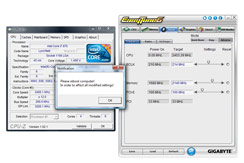

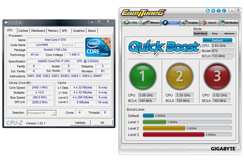
Left and centre - we didn't get on with the Advanced menu of EasyTune6, which we couldn't get to alter the Base Clock for CPU overclocking, and which has limited memory overclocking capabilities. Click to enlarge
To try to hack the security elements of the Smart6 - like the timelock and recording - we tried uninstalling the software, however, we were asked to enter a password even to do this. Also, the password was still retained even after removing and reinstalling the software, and will remain so until the BIOS is flashed. And if you flash the BIOS, you wipe all the information stored in it, so you can't get the private data stored in the BIOS that way either
We like the centralisation of the software design, but still find it strange that Gigabyte doesn't include everything: what about the @BIOS BIOS flash utility, which is strangely linked in by a small button to the right, or the Energy Saver or EasyTune software?
Gigabyte EasyTune6
We covered Gigabyte's EasyTune 6 software 15 months ago with the GA-EP45-DQ6 motherboard, and ultimately the core software design hasn't changed much. It still includes both simplified and advanced overclocking tools for CPU and graphics, plus a few other tools. However, the available options for software overclocking have obviously changed to reflect the Lynnfield CPU and P55 chipset.Unfortunately, the Base Clock slider in EasyTune6 doesn't seem to work that well - we tried to use it to change the Base Clock in Windows to find the maximimum attainable stable value, but selecting the setting in the software and hitting the 'Set' button didn't actually affect the CPU according to CPU-Z. Restarting the system, we found the BIOS wasn't changed either.
Changing the memory frequency strap (the tool doesn't let you adjust the frequency in single MHz, only the multiplier) required a reboot too, but at least this worked. However, considering you're resetting the system anyway why not just adjust your memory frequency from the BIOS? At least then you can adjust the frequency by single MHz, and also play with the timings and voltage.
The QuickBoost feature is mirrored as part of the Smart 6 software, and is Gigabyte's answer to auto-OC hardware on Asus and MSI boards. Basically you click and button and it sets the system to a pre-set baseclock overclock. The system still needs to be restarted though - it's not an on-the-fly process and it doesn't evaluate each system performance for its own merit like the competition does.
The EasyTune concept is (still) good, but it clearly needs some work.



Left and centre - we didn't get on with the Advanced menu of EasyTune6, which we couldn't get to alter the Base Clock for CPU overclocking, and which has limited memory overclocking capabilities. Click to enlarge
Gigabyte Smart 6
Smart 6 is Gigabyte's major value-add to its P55 range, although its appeal is far more widespread than just the overclocking community. Smart 6 includes several applications:- Smart Quickboot: Which is just a more obvious way to set the S3 sleep state in the BIOS and enable Hibernation within the OS. Even if the user selects shut down with this setting enabled, the system will go into Hibernate instead. It may mirror what's already available by Windows, but Smart Quickboot does make this handy feature more obvious, and easier to understand and use than diving into the BIOS andknowing where to enable Hibernate instead of Shut Down.
- Smart Quickboost: Is the same as featured in EasyTune6 above.
- Smart Recovery: Is Gigabyte's method of automated backup of files (but not complete OS images however) that can be kept up to 60 days. Firstly, select a percentage of a partition/drive to use, then Smart Recovery will hide this from use. Gigabyte claims even reformatting the drive will retain this partition and save the data, but we haven't tested this.
- Smart DualBIOS: Acts as a personal recorder for dates and important passwords which are saved in the BIOS - even if the OS is lost, the information can still be accessed after a reinstall. The downsides are that updating the BIOS wipes this data, you can't assign which BIOS the data is saved to (to prevent the loss) and you can't pull the data off the BIOS in a file. You can store passwords in Smart DualBIOS, but all those stored passwords are only protected by a single password. That's little different from storing passwords in a browser memory though, and what little chance is there that someone will write malicious code just to target Gigabyte P55 motherboards?
- Smart Recorder: A great idea for businesses or family PCs that could use recording access times to catch out-of-hours users, or simply to clock how much time you're using your PC. It also includes a file monitor to track what files are changed and accessed.
- Smart Timelock: Finally, this software can be used to lockout a PC user for a certain period of use, or between particular hours of the day. Again, since this software is password-protected and BIOS-level recorded, it's quite difficult to get around. Weekday and weekends are treated separately too. However, Gigabyte's maximum hours of use a day is limited to just eight.
To try to hack the security elements of the Smart6 - like the timelock and recording - we tried uninstalling the software, however, we were asked to enter a password even to do this. Also, the password was still retained even after removing and reinstalling the software, and will remain so until the BIOS is flashed. And if you flash the BIOS, you wipe all the information stored in it, so you can't get the private data stored in the BIOS that way either
We like the centralisation of the software design, but still find it strange that Gigabyte doesn't include everything: what about the @BIOS BIOS flash utility, which is strangely linked in by a small button to the right, or the Energy Saver or EasyTune software?

MSI MPG Velox 100R Chassis Review
October 14 2021 | 15:04



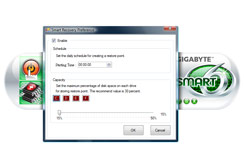
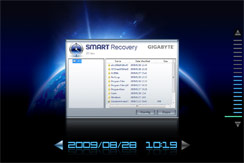

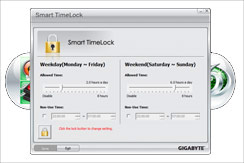
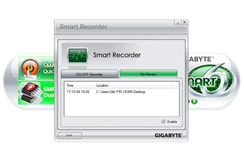







Want to comment? Please log in.